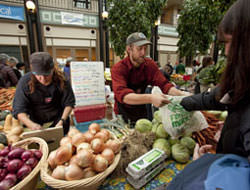

Courtesy Be Local Northern Colorado/Dan Bihn
The more than 40 vendors at the winter farmers markets in Fort Collins, Colo., sell products like meats, wine and cider, cheese, baked goods, coffee, and crafts.
Consumers’ demand for locally produced goods and their willingness to support local farmers continues to rise. From 2008 to 2009, the number of farmers markets increased 13 percent to 5,274 farmers markets nationwide, according to USDA statistics. From 2012 to 2013, the number increased 3.6 percent to more than 8,000. This demand is not likely to decrease because of cold weather.
“We do hear of more farmers markets trying to find ways to extend their seasons,” says Erin Barnett from Local Harvest, a website that provides a comprehensive database of U.S. farmers markets. “Some offer a once- or twice-a-month schedule through the winter, or at least until the end of the calendar year.”
In New York, for example, more than 60 farmers markets continue operations throughout the state at both indoor and outdoor locations.
“Many farmers markets across the state have extended their stay and are decorated for the holidays, offering a wide variety of locally made or produced products that can make appealing gifts or additions to your holiday feasts,” says Patrick Hooker, the state’s agriculture commissioner.
However, winter farmers markets can provide more than holiday appeal. While products offered at winter farmers markets vary by region, they also differ from the spring or summer markets, Barnett says. The focus turns to animal and nonperishable products, such as meat, cheese, eggs, honey, preserves, syrups, crafts and storage vegetables.
The winter farmers market in Fort Collins, Colo., run by Be Local Northern Colorado, draws in two kinds of consumers: craft shoppers and regular farmers market goers. The market started in 2006 with one market in December and, because of its popularity, has expanded this year to 10 markets between November and April.
The market, which features more than 40 vendors, is also serving as the launching pad for a future year-round, indoor, “European-style” market, says Hill Grimmet, co-director of Be Local Northern Colorado.
For those lacking a nearby winter farmers market and who don’t feel grocery store food will suffice, the key is to plan ahead.
“Next year, people should start thinking about winter in the summer,” Barnett suggests. “They can grow extra food and preserve or store it, or stock up on storage crops at the farmers markets in the fall and keep things in their basements, freezers or refrigerators until needed.”




